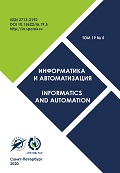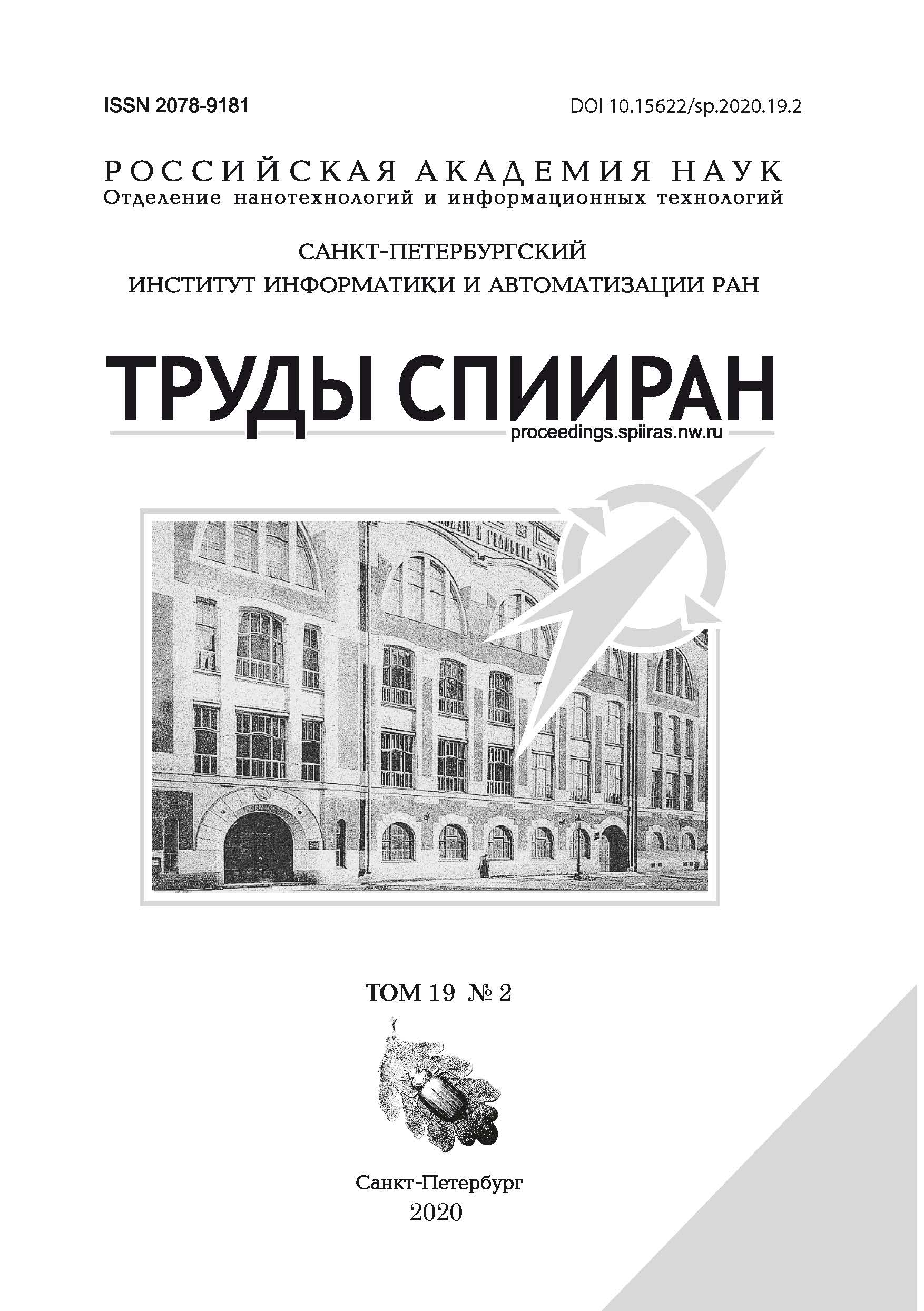Computational Algorithms for Reducing Rational Transfer Functions’ Order
Abstract
A problem of reducing a linear time-invariant dynamic system is considered as a problem of approximating its initial rational transfer function with a similar function of a lower order. The initial transfer function is also assumed to be rational. The approximation error is defined as the standard integral deviation of the transient characteristics of the initial and reduced transfer function in the time domain. The formulations of two main types of approximation problems are considered: a) the traditional problem of minimizing the approximation error at a given order of the reduced model; b) the proposed problem of minimizing the order of the model at a given tolerance on the approximation error.
Algorithms for solving approximation problems based on the Gauss-Newton iterative process are developed. At the iteration step, the current deviation of the transient characteristics is linearized with respect to the coefficients of the denominator of the reduced transfer function. Linearized deviations are used to obtain new values of the transfer function coefficients using the least-squares method in a functional space based on Gram-Schmidt orthogonalization. The general form of expressions representing linearized deviations of transient characteristics is obtained.
To solve the problem of minimizing the order of the transfer function in the framework of the least squares algorithm, the Gram-Schmidt process is also used. The completion criterion of the process is to achieve a given error tolerance. It is shown that the sequence of process steps corresponding to the alternation of coefficients of polynomials of the numerator and denominator of the transfer function provides the minimum order of transfer function.
The paper presents an extension of the developed algorithms to the case of a vector transfer function with a common denominator. An algorithm is presented with the approximation error defined in the form of a geometric sum of scalar errors. The use of the minimax form for error estimation and the possibility of extending the proposed approach to the problem of reducing the irrational initial transfer function are discussed.
Experimental code implementing the proposed algorithms is developed, and the results of numerical evaluations of test examples of various types are obtained.
References
2. Voronov A.A. Vvedenie v dinamiku slozhnyh upravljaemyh sistem [Introduction to the Dynamics of Complex Controlled Systems ]. M. : Nauka. 1966. 351p. (In Russ.).
3. Kim D.P. Teorija avtomaticheskogo upravlenija. Mnogomernye, nelinejnye, optimal'nye i adaptivnye sistemy [Theory of automatic control. Multidimensional, nonlinear, optimal and adaptive systems]. M.: Fizmatlit. 2016. vol. 2. 441 p. (In Russ.).
4. Antoulas A.C. et al. Model Order Reduction: Methods, Concepts and Properties. Coupled Multiscale Simulation and Optimization in Nanoelectronics. 2015. pp. 159–265.
5. Vishwakarma C.B., Prasad R. Time domain model order reductions using Hankel Matrix Approach. Journal of Franklin Institute. 2014. vol. 351. pp. 3445–3456.
6. Alsmadi O.M.K., Abo-Hammour Z.S. Substructure Preservation Model Order Reduction with Power System Model Investigation. Wulfenia journal. 2015. vol. 22(3). pp. 44–55.
7. Harutyunyan D. et al. Advanced Topics in Model Order Reduction. Coupled Multiscale Simulation and Optimization in Nanoelectronics. 2015. pp. 361–432.
8. Benner P., Hinze M., ter Maten E.J.W. Model Reduction for Circuit Simulation. Lecture Notes in Electrical Engineering. 2011. vol. 74. 317 p.
9. Hochman A. et al. Reduced order models for electromagnetics. IEEE Transactions Antennas and Propagation. 2014. vol. 62. no. 6. pp. 3150–3162.
10. Romano D., Antonini G., Grossner U., Kovacevic-Badstuebner I.F. Circuit synthesis techniques of rational models of electromagnetic systems: A tutorial paper. International Journal of Numerical Modelling Electronic Networks Devices and Fields. 2019. vol. 32. no. 5. pp. e2612.
11. Benner P., Gugercin S., Willcox K. A Survey of Projection-Based Model Reduction Methods for Parametric Dynamical Systems. SIAM Review. 2015. vol. 57. no. 4. pp. 483–531.
12. Bai Z. Krylov subspace techniques for reduced-order modeling of large-scale dynamical systems. Applied Numerical Mathematics. 2002. vol. 43. no. 1-2. pp. 9–44.
13. Heres P.J., Schilders W.H.A. Orthogonalisation in Krylov subspace methods for model order reduction. Scientific Computing in Electrical Engineering. 2006. vol. 9. pp. 39–43.
14. Zimmerling J., Druskin V., Zaslavsky M., Remis R.F. Model-order reduction of electromagnetic fields in open domains. Geophysics. 2018. vol. 83(2). pp. WB61-WB70.
15. Rusakov S.G., Gourary M.M., Ulyanov S.L., Zharov M.M. The Concept of Redundancy for Techniques of Model Order Reduction in Circuit Simulation. International Conference “Mathematical and Informational Technologies” (MIT-2013). 2014. pp. 260–266.
16. Phillips J.R., Silveira L.M. Poor Man’s TBR: a simple model reduction scheme. IEEE Transactions on Computer-aided Design. 2005. vol. 24. no. 1. pp. 43–55.
17. Gourary M.M., Zharov M.M., Rusakov S.G., Ulyanov S.L. [Model Order Reduction of Electrical Circuits Taking Account of External Networks Characteristics]. Informacionnye tekhnologii – Information Technology. 2018. Issue 24. vol. 9. pp. 563–572. (In Russ.).
18. Bañuelos-Cabral E.S., Gutiérrez-Robles J.A., Gustavsen B. Rational Fitting Techniques for the Modeling of Electric Power Components and Systems Using MATLAB environment. Rational Fitting Techniques for the Modeling of Electric Power Components and Systems Using MATLAB Environment. 2017. pp. 1–46.
19. Coelho С.P., Phillips J.R., Silveira L.M. Robust raаional function approximation algorithm for model generation. Proceedings of the 36th annual ACM/IEEE Design Automation Conference. 1999. pp. 207–212.
20. Knockaert L., Ferranti F., Dhaene T. Vector Fitting vs. Levenberg-Marquardt: Some experiments. 2009 IEEE Workshop on Signal Propagation on Interconnects (SPI). 2009. pp. 1–4.
21. Singh R., Chatterjee K., Singh J. A Mixed Approach for Approximation of Higher Order Linear Time Invariant Systems // International Journal of Engineering & Technology. 2018. vol. 7. no. 4.39. pp. 375–380.
22. Singh J., Chatterjee K., Vishwakarma C.B. Model order reduction using eigen algorithm. International Journal of Engineering, Science and Technology. 2015. vol. 7. no. 3. pp. 17–23.
23. Rao P.S., Prasad R. Stable Mixed Reduced Order Models for Linear Dynamic Systems and their Qualitative Comparison. 2016 IEEE 1st International Conference on Power Electronics, Intelligent Control and Energy Systems (ICPEICES). 2016. pp. 1–4.
24. Besekerskij V.A., Popov E.P. Teorija sistem avtomaticheskogo regulirovanija. [Theory of Automatic Control Systems]. M.: Nauka. 1966. 752 p. (In Russ.).
25. Golub G., Van L.Ch. Matrichnye vychislenija [Matrix Computations]. M.: Mir. 1999. 548 p. (In Russ.).
26. Krjanev A.V., Lukin G.V., David U. Metricheskij analiz i obrabotka dannyh [Metric analysis and data processing]. M.: Fizmatlit. 2012. 280 p. (In Russ.).
27. Pleskunov M.A., Korotkij A.I. Operacionnoe ischislenie. Uchebnoe posobie dlya vuzov. [Operational calculus. Textbook for universities]. M.: Yurajt. 2018. 141p. (In Russ.).
28. Galeev E.M. Optimizaciya. Teoriya, primery, zadachi. Uchebnoe posobie. [Optimization. Theory, examples, tasks. Textbook]. M.: Lenand. 2018. 344p. (In Russ.).
29. Gourary M.M., Zharov M.M., Rusakov S.G., Ulyanov S.L. [Minimax Optimization in Circuit Design Problems]. Informacionnye tekhnologii – Information Technology. 2018. Issue 24. vol. 7. pp. 435–444. (In Russ.).
30. Greshilov A.A. Matematicheskie metody prinyatiya reshenij [Mathematical Decision-Making Methods]. M.: MGTU im. N.E. Baumana. 2016. 584 p. (In Russ.).
Published
How to Cite
Section
Copyright (c) Марк Моисеевич Гурарий, Сергей Григорьевич Русаков, Михаил Михайлович Жаров, Сергей Леонидович Ульянов

This work is licensed under a Creative Commons Attribution 4.0 International License.
Authors who publish with this journal agree to the following terms: Authors retain copyright and grant the journal right of first publication with the work simultaneously licensed under a Creative Commons Attribution License that allows others to share the work with an acknowledgement of the work's authorship and initial publication in this journal. Authors are able to enter into separate, additional contractual arrangements for the non-exclusive distribution of the journal's published version of the work (e.g., post it to an institutional repository or publish it in a book), with an acknowledgement of its initial publication in this journal. Authors are permitted and encouraged to post their work online (e.g., in institutional repositories or on their website) prior to and during the submission process, as it can lead to productive exchanges, as well as earlier and greater citation of published work (See The Effect of Open Access).






